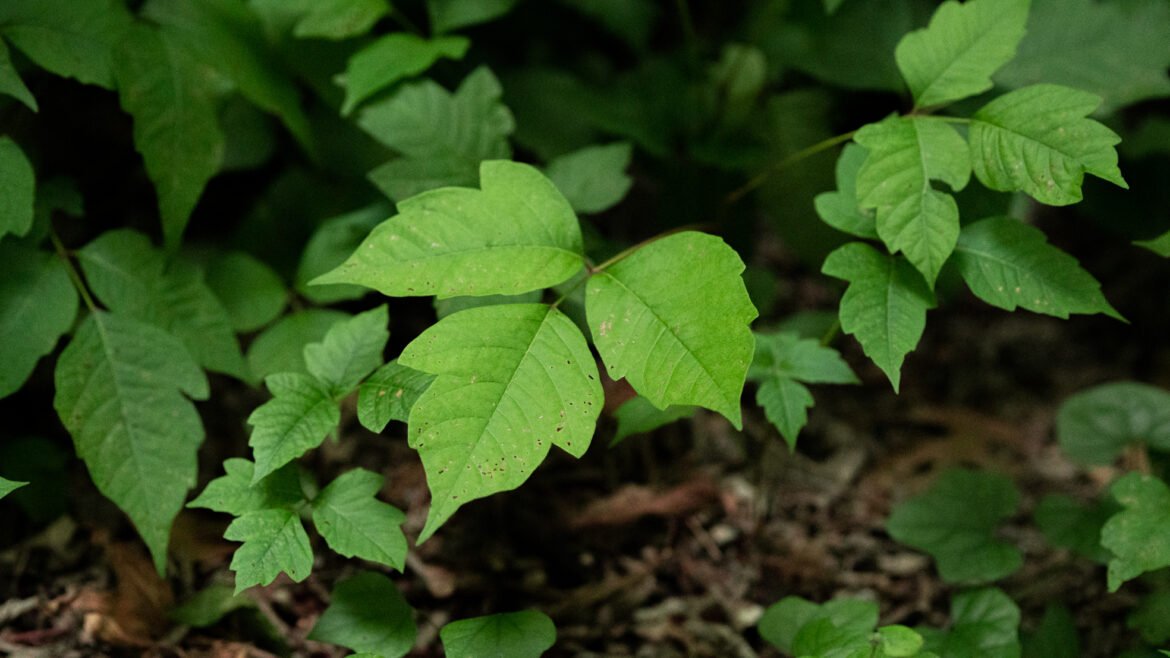Nature, with all its beauty, occasionally presents us with hidden dangers. One such threat is poison ivy (Toxicodendron radicans), a common plant found in North America. Identifying this plant can be as easy as 1, 2, 3. Poison Ivy, Poison Sumac, and Poison Oak, all have three leaves. Remember this old saying “Leaves of three, don’t touch me.” While its vibrant green leaves may appear innocuous, contact with poison ivy can lead to an uncomfortable and itchy rash.
What is Poison Ivy?
Poison ivy is a woody vine or shrub that belongs to the cashew family, Anacardiaceae. It is prevalent in forests, fields, and other wooded areas across the United States and Canada. Poison ivy leaves consist of three leaflets, which are glossy and range in color from green to reddish in the fall. The plant produces an oily resin called urushiol, which is responsible for the allergic reaction when it comes into contact with human skin.
Effects on People
The majority of people are allergic to urushiol, making poison ivy a common irritant. When the resin touches the skin, it triggers an allergic reaction in the form of an itchy rash known as allergic contact dermatitis. The rash typically appears within 12 to 48 hours after exposure, although it can take longer for individuals who have not encountered it before.
The symptoms of poison ivy rash include:
- Intense itching: The affected area becomes intensely itchy, leading to discomfort and difficulty in resisting the urge to scratch.
- Redness and inflammation: The skin in contact with the resin becomes red and swollen, indicating an inflammatory response.
- Blisters: Small fluid-filled blisters may develop, which can be a source of further irritation.
- Eruptions: The rash may appear as streaks, patches, or linear formations, depending on the manner of contact with the resin.
Poison Ivy Treatment Options
While the symptoms can be distressing, there are several treatment options available to alleviate the discomfort and promote healing. Here are some recommended approaches:
- Washing the affected area: As soon as you come into contact with poison ivy, wash the exposed skin thoroughly with soap and water. This helps remove the urushiol resin and minimize its spread.
- Topical creams and lotions: Over-the-counter hydrocortisone creams and calamine lotions can provide relief from itching and inflammation. These products help soothe the affected skin and reduce the severity of the rash.
- Cold compresses: Applying a cold compress or taking cool baths can help alleviate itching and reduce inflammation. Avoid hot water or scratching the rash, as these can worsen the symptoms.
- Antihistamines: Oral antihistamines like diphenhydramine can be taken to relieve itching and help manage allergic reactions. However, it’s important to consult a healthcare professional before using any medication.
- Prescription medications: In severe cases, where the rash covers a large area or causes significant discomfort, a doctor may prescribe stronger corticosteroids or oral corticosteroids to reduce inflammation and itching.
Prevention:
To prevent exposure to poison ivy, it is essential to learn how to identify the plant and avoid direct contact. Wearing protective clothing, such as long sleeves, pants, and gloves, can provide an additional barrier.
Poison ivy, with its irritating effects, is an unwelcome presence in many natural landscapes. Being aware of its characteristics and the potential consequences of exposure can help individuals take the necessary precautions. In case of contact, prompt treatment measures such as washing the affected area, using topical creams, and seeking medical advice when symptoms become worse.
Frequently Asked Questions about Poison Ivy
Poison ivy, a notorious plant found across North America, is infamous for causing itchy and uncomfortable rashes. Many people have questions about this troublesome plant, its effects on the skin, and how to treat the symptoms. Blelow we’ll address some of the frequently asked questions about poison ivy and provide useful information to help you stay safe.
What is poison ivy, and how can I identify it?
Poison ivy (Toxicodendron radicans) is a plant that grows in various forms—vines, shrubs, or ground cover—depending on the region. It typically has three shiny leaflets and can vary in color, appearing green in the spring and summer and turning red or yellow in the fall. The saying, “Leaves of three, let it be,” is a helpful reminder to identify and avoid poison ivy.
What causes the itching and rash associated with poison ivy?
The itching and rash from poison ivy are caused by an allergic reaction to an oily resin called urushiol. This resin is present in all parts of the plant, including the leaves, stems, and roots. When you come into contact with poison ivy and urushiol gets on your skin, it binds to proteins and triggers an immune response, resulting in the characteristic rash.
Is poison ivy contagious? Can I spread the rash to others?
No, poison ivy is not contagious. The rash cannot be spread from person to person by touching the affected areas. However, it’s essential to remember that urushiol can remain active on surfaces such as clothing, gardening tools, or pet fur, so it’s crucial to wash these items thoroughly to prevent re-exposure.
What should I do if I come into contact with poison ivy?
If you accidentally come into contact with poison ivy, it’s important to act promptly. Rinse the affected area with water within the first few minutes of exposure to remove as much urushiol as possible. Avoid touching other parts of your body to prevent the spread of the resin. Using soap or rubbing alcohol can also help remove the oils. Wash your clothes and any other items that may have come into contact with the plant.
How long does it take for a rash to appear, and how long does it last?
The rash usually appears within 12 to 48 hours after exposure, but it can take longer in some cases. The duration of the rash varies from person to person, but it typically lasts around one to three weeks. Severe cases or cases involving sensitive individuals may take longer to heal.
What are some common treatments options?
To alleviate the discomfort of a poison ivy rash, there are several over-the-counter options available. Calamine lotion, hydrocortisone cream, or antihistamines can help reduce itching and inflammation. Cool compresses and oatmeal baths can provide soothing relief. If the rash is severe or widespread, it’s advisable to consult a healthcare professional who may prescribe stronger topical or oral medications.
Can I develop immunity to poison ivy over time?
Some individuals may develop a degree of tolerance or reduced sensitivity to poison ivy over time due to repeated exposure. However, it’s important to note that the sensitivity can vary, and even those who have been exposed before can still develop a rash in subsequent encounters.
How can I prevent poison ivy exposure?
Preventing exposure is key to avoiding the uncomfortable symptoms of poison ivy. Here are a few tips:
- Learn to identify poison ivy and avoid contact with it.
- Wear long sleeves, pants, and gloves when in contact with plants.
Learn more about poisonous plants here,

